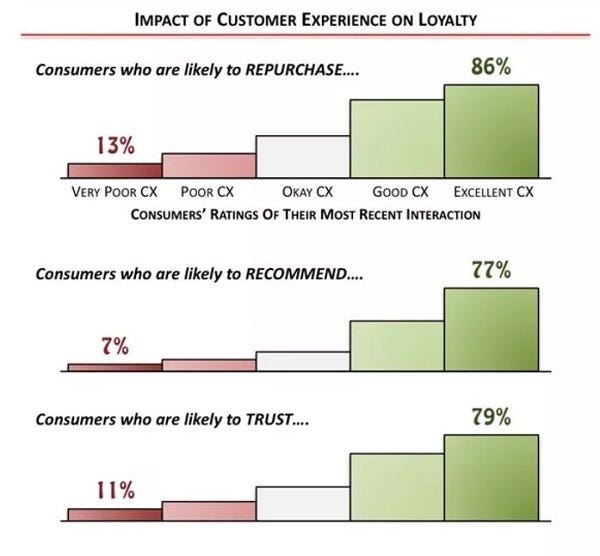For any brand or a company, it is imperative to keep launching new products or services to remain visible in the market. It is the era of surpassing customer expectations and delivering not only the best product but also the best customer experience. With 80% of product launches failing annually, companies are now counting on intelligently woven customer experience strategies and novel technology to find their way to customers’ hearts.
According to a survey by Salesforce Research, 66% of customers say it takes more for a company to impress them with new products and services than ever before.
This study indicates that companies have to do come up with smarter strategies to make their product launches successful. Providing a superior customer experience is the first step to win their customers’ hearts.
Customers desire exceptional experience
With the advent of technology and the availability of countless alternatives, customers have gradually become more demanding. Experience is now the preeminent differentiator among brands. Spending on improving customer experience is an investment that bears ever-increasing lucrative results.
According to research done by the Temkin Group, companies that make $1 billion annually can expect to earn, on average, an additional $700 million within three years of investing in customer experience.
Customers relish personalized experiences and look for brands that emotionally connect with them.
For a new product, the brand should aim to exceed the expectations of the customers by providing them with not only an amazing product/service but also a delightful experience, which can then lead to amplified growth of the product and the brand.
Do all the planning beforehand
To have a successful product launch, the managers have to strategize everything beforehand. Due to the increasing significance of customer experience, every product launch now needs to have a game plan to excel in this category.
“A goal without a plan is just a wish.”― Antoine de Saint-Exupéry
Alongside the marketing, operational, and financial plan, a strategy for providing unparalleled and excellent customer experience should also be developed. No matter how great your product is, most of the purchases will depend upon the experience that customers would receive at each touchpoint. Hence, there should be a framework to have a wow factor at each of them.
Company’s reputation is at stake with a new product
Customers are more likely to spread negative experiences as compared to the positive ones. In this age of digitalization, it is incredibly convenient to share reviews and experiences. A single bad review can take many customers away as a large number of people rely on these reviews.
“It takes 20 years to build a reputation and five minutes to ruin it. If you think about that, you’ll do things differently.”— Warren Buffett, CEO of Berkshire Hathaway
The reputation of the parent company is at stake with every new product, as each product complements the legacy of the company. Positive experiences by the early adopters of the product serve as the best marketing strategy. With excellent user experience, the new product revs up the profit margins of the company.
A great CX transforms early adopters to brand loyalists and augments customer retention
Excellent customer experience leads to a high customer satisfaction rate and high customer retention. In a study of 10,000 US consumers, Tempkin Group found that 86% of those who received a great customer experience were likely to repurchase from the same company. An excellent customer experience builds brand loyalty among the customers and spreads positive word of mouth, which expands the customer base.

According to a study conducted by Rosetta, engaged, and satisfied customers buy 50% more frequently, spend 200% more each year, and are five times more likely to display brand loyalty.
A new product needs high customer retention as few people try the product initially. So, the experience offered should be captivating enough to keep bringing back customers to your product.
Excellent CX guarantees profitability even for a new product
Companies like Amazon and Google have reached the pinnacle of success based on the customer experience they continue to provide. Exceptional customer experience yields customer loyalty and high profitability. Formulating a strategy for delivering superior customer experience at every stage is more critical for new products. The reason is that people form perceptions based on the first interaction with the brand or its product. Therefore, companies need to deliver a wow factor at each touchpoint so that the customers keep coming back for more.
According to New Voice Media’s 2018 Serial Switchers report, poor customer service is costing businesses more than $75 billion a year.
Customer demands are now more complex than ever before. They keep fluctuating between brands to avoid unpleasant experiences. Therefore, companies must be proactive in crafting out a framework for delivering superior customer experience.
Forrester discovered that customers with better experiences said they were less likely to go elsewhere and more likely to recommend it.
A study by Forrester found that CX leaders delivered compound annual revenue growth rate (CAGR) of 17% compared to just 3% for CX laggards in the period of 2010 to 2015. These rates could have been influenced by other factors too, but Forrester discovered that customers with better experiences said they were less likely to go elsewhere and more likely to recommend it.
A new product has an immense potential to drive up the revenues of the company. If the product launch goes successful, word of mouth will automatically create a customer base of raving fans.
Final Word
Customer experience is the ultimate game-changer for companies today. It can either drive a company to the zenith of prosperity or bury it deep into the earth. A framework for providing a great customer experience for a new product can aid in winning the race against competitors. Plus, it can thrust a new product into the limelight. Therefore, having a solid CX strategy before a product launch is crucial not just because its a competitive differentiator but also because the product’s market acceptance depends largely upon it.
